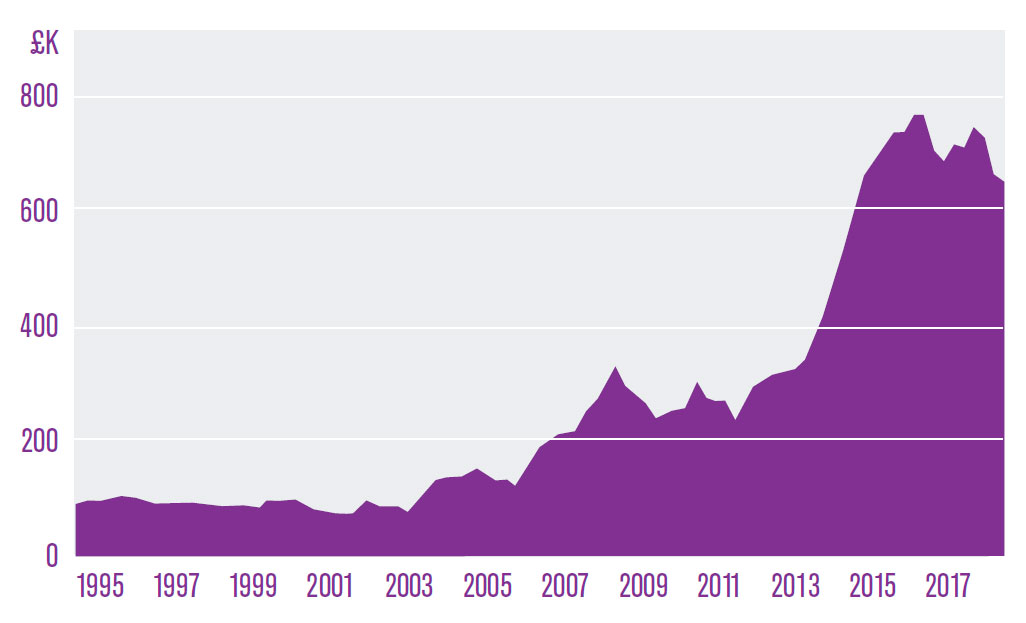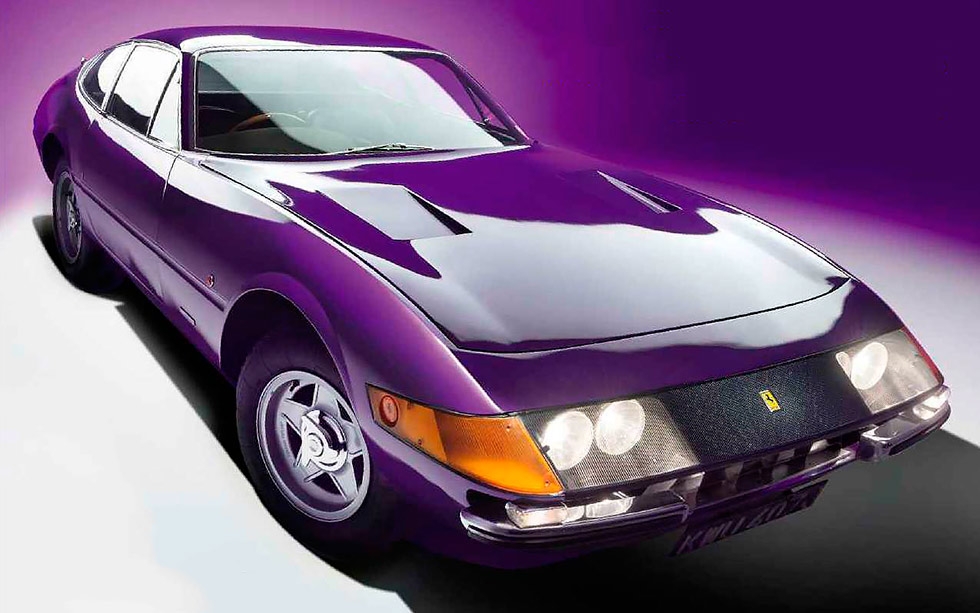
Ferrari’s first supercar – what makes it so special? Insiders reveal all… Those in the know divulge the delights of owning Ferrari’s first supercar – starting with a motor sport enthusiast who drives his Daytona all over Europe. Words Glen Waddington. Photography Tim Andrew.
SUBJECT OF DESIRE Why is Ferrari’s first supercar so desirable? Owners – and the car’s designer – explain.
You know, you’re quite lucky that it’s looking so shiny,’ smiles Bertie Gilbart-Smith with a glint in his eye. ‘I don’t polish it very often. But I’m chief steward for the Concours of Elegance and, even though the Daytona wasn’t taking part at Hampton Court this year, those chaps from Autoglym insisted on polishing every car that was there. I simply had to chamois it before bringing it to the studio.’
‘WHILE THE DAYTONA LOOKED BACK OVER A PROUD 20-YEAR HISTORY, IT MARKED A NEW DIRECTION FOR FERRARI’
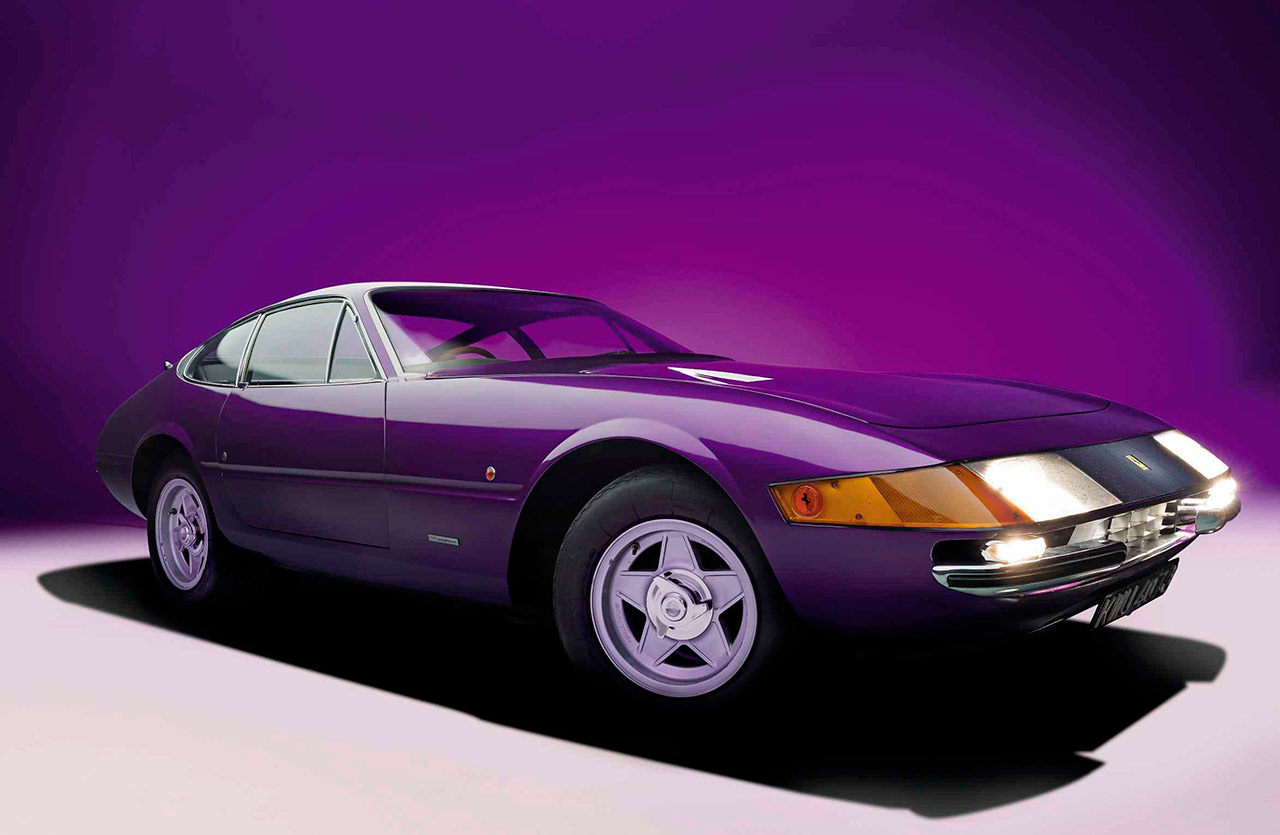
The impression might be of a car that’s not cared for, but that is very clearly not the case. Bertie has owned the Daytona for 11 years and loves it to bits. And it’s to his credit that he derives his enjoyment from driving it rather than looking at it, gorgeous though it is. If gorgeous is quite the word, that is.
Some years ago I wrote of the Daytona that ‘it’s diabolically beautiful, with stupefying proportions that pin down your aesthetic senses, only for its deft and subtle detailing to coax them back’. Purple prose that applies equally to this purple car. It’s still knock-em-dead, and I’ve been up close and personal with quite a few in-between. And much has happened in the Daytona’s world in that intervening period. Is there another car that’s seen such volatility in its values? The ’68 car that I drove in 2001 was valued at £85,000, way down on previous peak prices (£500,000 in the late 1980s), and I’ve driven one since – a decent one – that was on the market for £55,000. Such days are gone; the best are now easily beyond those previous boom prices. I’m not going to embarrass Bertie here and ask what he paid for his or what it’s worth. Safe to say that, 11 years ago, a Daytona would have bought quite a comfortable home, and now it’d buy a more comfortable one.
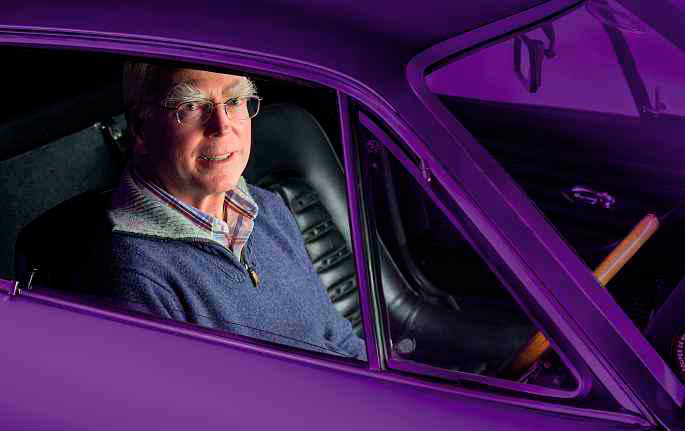
That colour, though. We don’t really call it purple. I’ve seen the bill of sale. It’s Viola. And it comes with a restrained (and wholly original) black hide interior. The glorious hue of that paint was a second thought, when the factory order was modified from the intended Grigio Ferro. Changes of mind don’t come much more, well, vivid than that.
‘If you can live with the colour, you’ll never get a better car,’ says Bertie. ‘That’s what I was advised. Well, in the pictures it had looked blue, so it was something of a shock to the system when I went to see it. But the grey would have been a bit dull, perhaps, and I really don’t like them in red. As with any car, you buy the best there is. It’s always cheaper in the long run.’
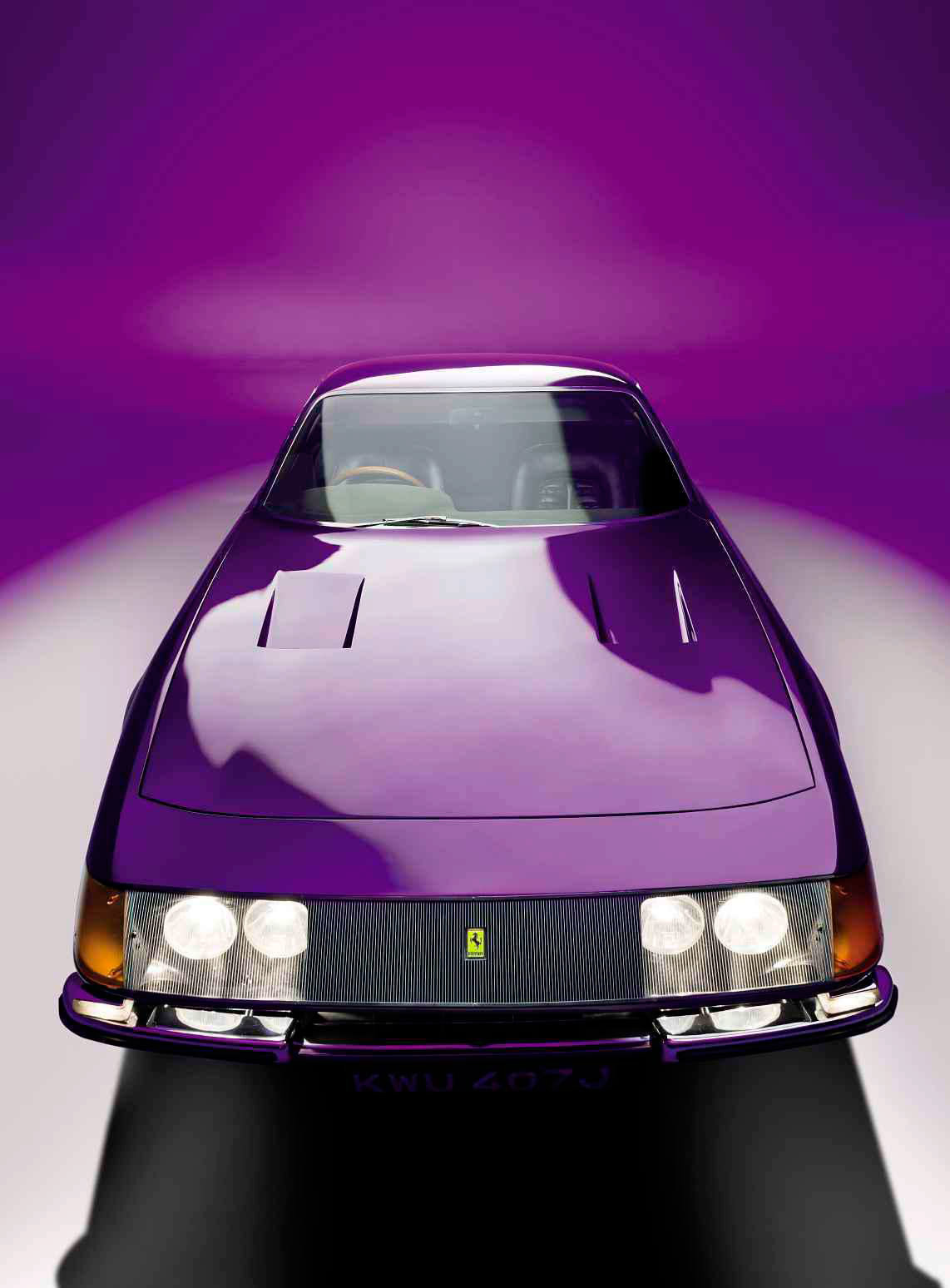
And this was the best there was when Bertie went hunting. ‘I’ve had my AC Ace since 1965, when it was five years old. Lord Cross [the first British person to buy an AC Cobra, the fourth in Europe] bought his Cobra just a few months ahead of that and he did so much with it – I would have loved that car. When he died, I’d hoped to buy it but it wasn’t to be. And I had all my ducks in a row, so to speak. I’d never dreamt before that I could own a Daytona but I started looking. I wanted right-hand drive, Plexiglas headlamps, and I saw quite a lot. But nothing appealed until I saw this one.’
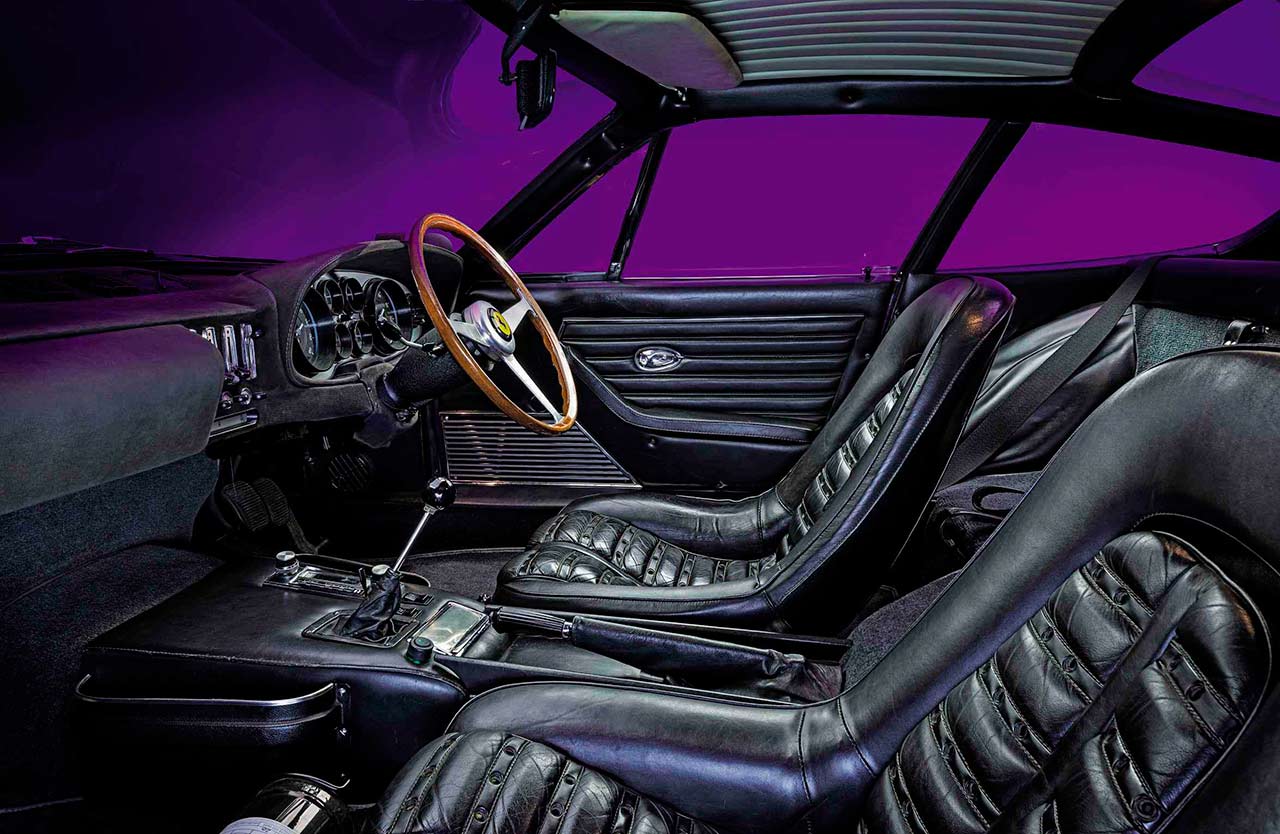
And to want one, whatever the colour, is entirely understandable.
It’s worth, at this point, decoding the car’s nomenclature: 365 GtB/4 Daytona. The latter word is an epithet coined following the Scuderia’s 1-2-3 finish in the 24-hour race at that Florida circuit in 1967 – not with a 365, even a Competizione, but with a 330 P3/4, a 330 P4 and a 412 P.
Naturally, the Competizione racing version followed in 1970, two years after the road car was launched, and a year after an aluminium-bodied car had raced (and crashed out) at Le Mans. The Competizione scored multiple class wins, notably at Le Mans among privateer entrants (including fifth overall in 1971). A total of 15 were built, in three batches of five (the last coming in 1973), all featuring lightweight aluminium and glassfibre bodywork, Plexiglas windows, and an engine that had been tuned from the standard 352bhp of the first cars up to 400bhp and then 450bhp in the second and final batches respectively.
But the Daytona was really a road car. There were 1284 closed coupés (the ‘B’ for berlinetta) produced between 1968 and 1973, plus 122 GTS spider versions, all with the same 4390cc four-cam Colombo V12 (365cc per cylinder, hence the ‘365’; ‘4’ for the camshafts). Mechanically, the car followed on from the 275 GTB, with a fivespeed transaxle transmission and coil-sprung wishbone suspension all-round, all seen for the first time on the 275, which had made its debut in 1964 and marked the end of live axles for the company.
Equally, that four-cam V12 was a development of the 275’s, and part of the long line of V12s developed by Gioacchino Colombo that could chart its heritage right back to the first 125 S of 1947. The 275’s 3.3-litre was the last development to share the original’s 58.8mm stroke, and can really be considered as the final step beyond the definitive 3.0-litre 250 engine, which was so successful in racing yet spawned equally iconic road cars. The final 275 GTB/4 featured a dry sump, six-carb induction and a four-cam cylinder head configuration, with the valve angle reduced to 54º for compactness. The twin-cam-per-bank layout meant that all 24 valves were aligned perpendicularly to the camshafts.
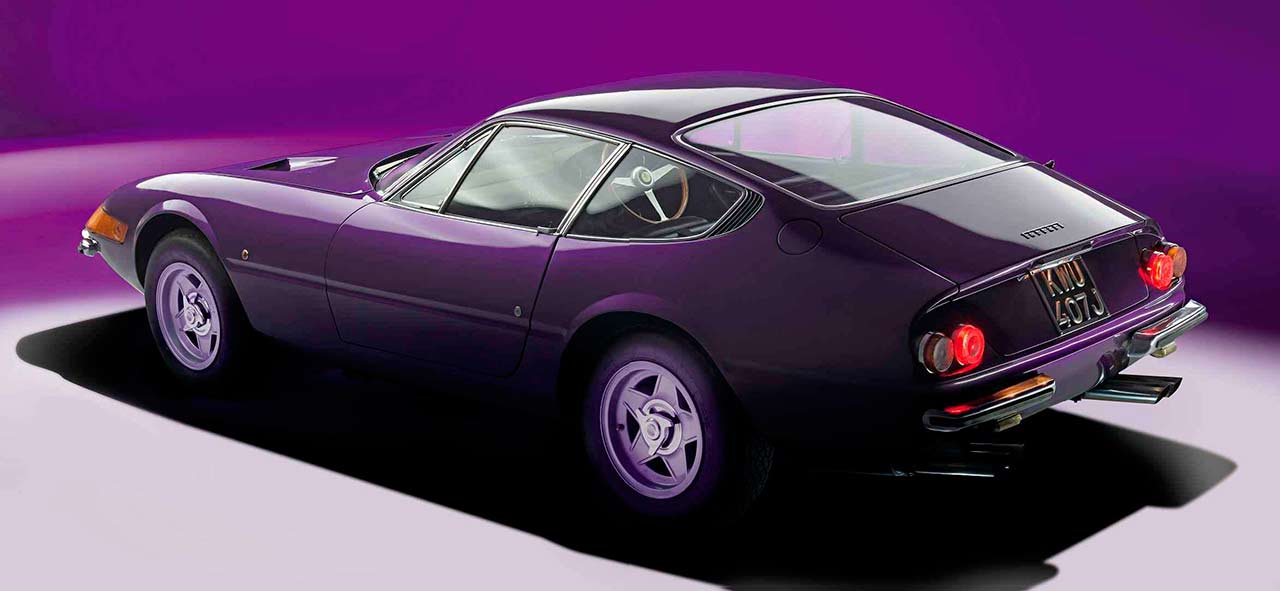
Colombo’s engine had been upgraded for the 4.0-litre 330 of 1963, its new block featuring wider bore spacings. The Daytona’s engine included many of the 275’s developments, and took as its basis the 330’s block but with a wider bore. It was the first 365 model to feature a dry-sump, four-cam layout; in other applications (such as the California, and the GT 2+2) the engine was run in softer tune, appropriate for more luxurious GT cars. And while the Daytona was certainly a GT, and one that could race, it was also Ferrari’s first true supercar.
Yes, while the Daytona looked back over a proud 20-year history, it marked a new direction for Ferrari. The first cars were built during the takeover by Fiat, so even the company itself was changing – a sign of the times. And while the 275 GTB could be called the last of the classical Ferraris, there’s no shame in suggesting that the Daytona was the first of the modern era. Its styling, by Pininfarina’s Leonardo Fioravanti, certainly nodded towards the future, with wind-cheating lines in place of classical curves and Plexiglas fairings over the headlamps… until US legislation forced a move to retractable covers in 1971.
If the Daytona’s front-engine, rear-drive layout was a step behind the competition at Lamborghini, the company explored the possibilities of a mid-engined road car right alongside, with its junior brother, the Dino 206. It took the next generation of Ferrari supercar – the 512 BB of 1973 – to follow the Miura’s lead, though Ferrari’s car owed more to its own racers than it did to developments at nearby Sant’Agata. And anyway, the Daytona had already earned the mantel of fastest road car of its day.
That’s enough of a history lesson for now. With practised ease, Bertie swings open the Daytona’s door, falls into its low-set seat, and reverses it from its parking barn in a single arc. Time for a drive.
‘One of my favourite things about it is the way it starts,’ he smiles. ‘That voice as it turns over and fires, it just gets the hairs on your neck. And it’s so effortless to drive. The only problem is that it’s at its happiest at 90mph – way happier than it is at 70mph. You just can’t drive it as it’s meant to be driven very often, these days.’

He’s a confident driver, placing the Daytona perfectly on the road and unafraid to explore the rev range once the oil is warm. ‘There’s so little body roll and it barely dips under braking. Yes, it has a very firm ride; you need to try one before you buy it, and to accept it for what it is. That’s the whole point. But Continental trips are wonderful.’
In fact, long trips are at the root of Bertie’s love for the car. ‘Back in the 1980s I was invited by an AC owner friend to drive his Daytona from Colorado to Pebble Beach in California. There was a Ferrari Owners’ Club meeting at Laguna Seca and we hurled the Daytona around there. It was the first time I’d driven one and I found they’re totally different at high speed – they’re not designed to do anything other than be driven hard. And when it’s hot – really hot – the gearshift really is like a knife through butter.’
There have been long drives in this one too: ‘My longest trip was to the Modena Cento Ore rally – 3500 miles in total. We drove to the start in Rimini via the Stelvio Pass and I stayed on after with friends to do the scrutineering at Monza, then headed back through Switzerland via as many passes as possible. That was a fun trip.’
He pulls over and invites me to take the wheel. I pull away and gradually build speed, reminding myself of the way every millimetre of throttle travel translates not only into increased pace but also changes in the V12’s tone, from the busy bluster of its idle via a wailing mid-range to a full-on roar by the upper reaches of the revcounter.
Bertie is a calm passenger and relays some of his car’s history: ‘It was in OK condition when it was sold in 1977. The engine, transaxle, bearings and brakes were all rebuilt by the second owner, Jim Whitehouse. He owned it until 2006, and it was resprayed in the original Viola during that time too. He was a BRDC member, and the owner of Mini racing specialist Arden Engineering.’
The car came with no bills because all the work had been done in-house. ‘I was told Jim Whitehouse was “just a garage owner”. But he was one of the best garage owners who could have owned it. There are so many notes in the handbook, all the settings he worked out so it would run at its best for his use.
‘When I found it, it was spotless underneath. So original everywhere too, especially under the bonnet. People ask why I don’t replace the fusebox, as the labelling has faded. But why? It’s part of its history.’
The going gets a little twistier and the steering certainly gives you a work-out, yet the gearshift’s movement through the open gate responds positively to an assertive left hand. Meanwhile, Bertie continues: ‘I met Jim Whitehouse once at Silverstone and told him I thought I needed to change the oil temperature gauge. “Why?” he asked. “Everything works perfectly on that car! It really doesn’t even register unless you’re driving it really hard.”’
Regular use and maintenance ensure that the Daytona still drives with great verve: there’s no stickiness in the controls, and no dead spots as you accelerate. Equally, there are no creaks in the body or through the suspension, and the car feels wonderfully tight yet alive with it.
‘There’s been no need for any major work in the 11 years I’ve owned it, just maintenance. Most recently I replaced the limited-slip plates in the differential. It’s nearly 50 years old! And I’ve never had any problems. I don’t do trackdays, they don’t appeal. I would rather drive to a track I’ve never been to before and enjoy the journey. I can’t think of many cars I’d rather drive a long way in. It even has a decent-sized boot.’
Bertie combines his love for the Daytona with another occupation. He says: ‘I began scrutineering in the late 1960s and I go all over Europe with the Historic Grand Prix Cars Association. I drive to every race in one of my cars, including the Daytona. I bought it to enjoy it. Cars can get damaged but they can also be repaired. If it rains, it rains. If you were worried about where to park it, you’d never use it. We’re only custodians.
If you use them they work better as a result.’ And he’s equally nonchalant about what it might be worth. ‘There’s no point buying a car and hoping it will increase in value. That’s a bonus if it happens, but you have to keep it going along the way and invest in maintenance and repairs. I don’t play golf but many that do come back with a smile on their faces. That’s why they pay green fees. And it’s exactly the same with a car.’ It’s difficult to disagree with that.
‘IT’S TO BERTIE’S CREDIT THAT HE DERIVES ENJOYMENT FROM DRIVING IT RATHER THAN LOOKING AT IT, GORGEOUS THOUGH IT IS’
TECHNICAL DATA FILE SPECIFICATIONS 1970 Ferrari 365 GTB/4 Daytona
Engine 4390cc V12 Colombo, DOHC per bank, six Weber 40DCN20 carburettors
Power 352bhp @ 7500rpm / DIN
Torque 318lb ft @ 5500rpm / DIN
Transmission Five-speed manual, rear-wheel-drive
Steering Worm and roller
Suspension Front and rear: double wishbones, coil springs, telescopic dampers, anti-roll bar
Brakes Vented discs
Weight 1633kg
Top speed 173mph
0-60mph 5.9sec
Daytona People Words Robert Coucher and Massimo Delbò
Max Girardo
‘I sold my Daytona so I could start my company’
Great cars have been my life. I became a director of Bonhams of Europe in 2006 and then spent ten years with RM Sotheby’s, where I was managing director. I absolutely loved it, especially the actual auctioneering – it’s just such fun. My father was a rally driver in the 1970s and I’m a collector, so classic cars are in my blood. But there comes a time when you have to go out and do something on your own. Last year we set up Girardo & Co and really started to burn money. Sadly, I realised I’d have to sell my beautiful Rosso Dino Ferrari Daytona to set up the business. The Ferrari was one of the best I have ever seen: that orangey red with beige interior and I had a silver stripe painted across the front, which was an option on the pop-up headlight cars. It looked fabulous, so 1970s. I kept it on the original-spec slim alloys and those cool black Italian numberplates.
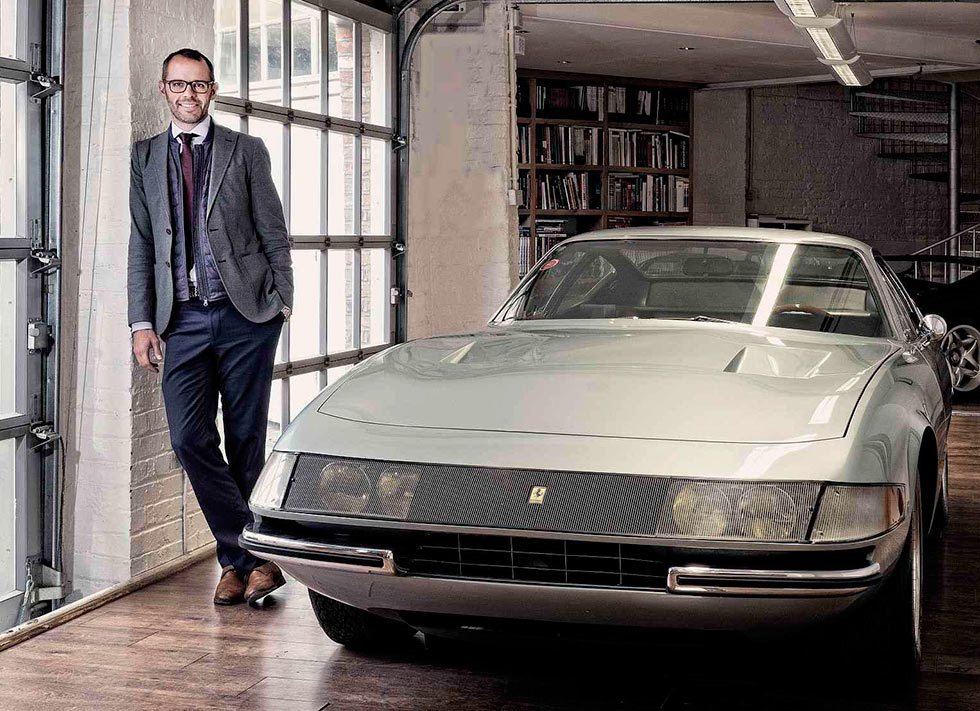
I’d known the Daytona for about seven years. It had belonged to a scrap metal dealer in the south of Italy. I’d go to his premises, which looked like a bomb site, and hidden away in what was basically a house was his collection of immaculate Ferraris. It was quite preposterous. Anyway, he sold his collection to a well-known Ferrari dealer in Milan, from whom I bought the Daytona. I knew I just had to pull the trigger! I didn’t tell my wife how much it cost. I was in my thirties and must have been mad but the Ferrari seemed to go up in value every week. Makes me seem clever…
It was fabulous to drive as it pulled like a train. I mean, a front-engined V12 with quad cams and six Weber carbs – it doesn’t get much better than that. Yes, it was a bit heavy to parallel-park but the car was never designed for that. I loved driving it. As well as being really fast it was comfortable and even had its original eight-track stereo.

Yes, it drank fuel and the quarterlight window fasteners would break off but apart from that the Daytona was dead reliable and easy to live with. I have done some epic drives over the years but one of the best was in the Daytona. I strapped my young son into his baby seat and we set off to West Sussex. He, of course, fell fast asleep but what a joy to be driving him through the countryside in my Ferrari Daytona!
And the looks! We lived in a small house in Putney with a tiny garage. The Daytona would only just squeeze in – I’d have to take off my shoes, remove my belt, wind down the window and squeeze out through it because the garage was too narrow to open the door. It had a glass window facing the garden and often I’d just go and look at the Ferrari. But someone made an offer and then I started Girardo & Co at our great mews premises in Fulham… But I do miss it. Fortunately, I know exactly where the Daytona is. It’s in Norway and I’m keeping an eye on it.
Leonardo Fioravanti
‘I designed the Daytona – in a week’
I desIgned the Daytona at home during my free time, in about a week. Back then, in December 1966, I was a young designer at Pininfarina, and I had been credited with designing the production version of the Dino. Today I can claim to have designed 11 Ferraris, and I oversaw another 18 during my years as CEO at Pininfarina Studi e Ricerche.
I started to think about a replacement for the 275 GTB/4 when I shared drives in one with Pier Ugo Gobbato, Ferrari’s general manager, on journeys between Turin and Maranello. It wasn’t the great car we tend to remember today. Side and rear visibility were terrible, a great minus for a racer such as myself; the aerodynamics were not so good and even the shape wasn’t the best.
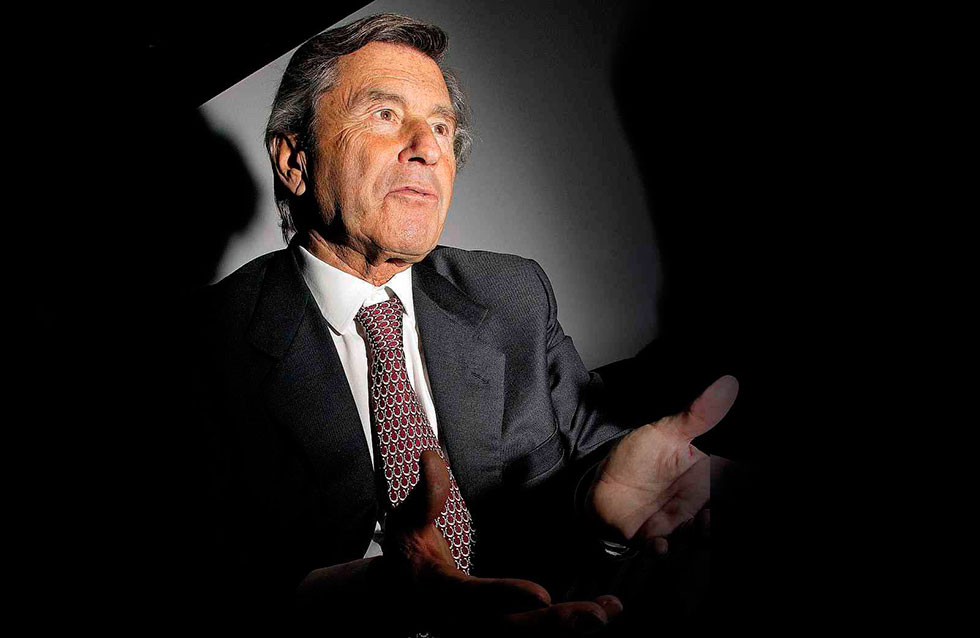
The problem was that the 275 was then still a young car and nobody would have accepted any effort to replace it so soon. But when all my sketches were ready, the full design drafted with all the correct views, I entered the the offices of Sergio Pininfarina and Renzo Carli. They quickly looked at it, exclaiming that I was crazy, that a ‘new 275’ was not in the programme of either Ferrari or Pininfarina.
But then, instead of ripping it up, they went on looking. They decided to show it to Enzo Ferrari and, a few days later, they came back with the news that Ferrari’s engineers were checking the project.
Then I knew we were safe because I’d kept the basis of the 275. And what happened next was important: we skipped a stage and went on directly with the one-to-one scale drawing, an unusual procedure. When that was ready, Enzo Ferrari himself came to Cambiano, and for the first time I was invited into the meeting too.
He walked slowly around the model, then looked at me and asked if I was happy. I was shocked that he talked to me and replied that, to avoid it looking like an Opel, with the wheels too far inside the wheelarches, we should widen the track by at least 5cm each side. He looked at me with a spark in his eyes and replied, allowing me a 6cm increase in total! He knew what I wanted, but he knew I did not have the courage to ask for it. From then on, everything developed very fast. I used only 5cm of the six he’d allowed, to avoid any problems with the engineers in Maranello, and my only other challenge remained keeping the Plexiglas cover for the front lights.
I was able to prove to the Italian homologation office that the Plexiglas and the frame holding it were of no detriment to the strength of the headlamps, and their laboratory tests confirmed that I was not lying! But in America we had to adopt the pop-up versions because of the minimum required height of the headlamps.
I never thought then that I would still be talking about this car more than 50 years later but I was sure it came out well when, at the Paris motor show launch, I saw it close to the Dino. I thought the Dino, the first modern mid-engined Ferrari, was shaded by the traditional 365 GTB/4.
Geoffrey Marsh
‘I’ve owned mine since 1972’
I bought my Daytona new on 2 June 1972 from Colonel Ronnie Hoare’s Maranello Concessionaires in Egham. The last MoT certificate indicates it’s done 27,904 miles and it remains totally original, including the paint. It’s the best classic road car I have owned.
In my first year I did 9000 miles. A memorable trip was taking the early ferry to Le Havre, driving through Rouen and Aix-en-Provence and arriving in Monte Carlo – a 730-mile run in ten hours. The Daytona is superb at these fast Continental journeys and there’s a lot of nonsense spouted about it being heavy and ungainly. I’m a pretty fit 78 years of age and I still find the car wonderful to drive. At anything over 5mph the controls are light and communicative and on the open road it is still a fantastic experience.
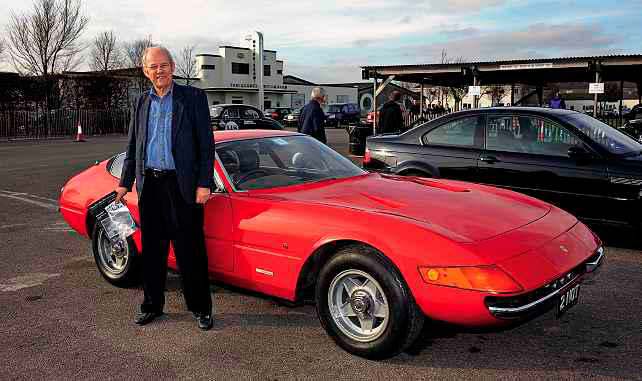
The trouble is that most Daytonas have been ‘restored’ with the emphasis being cosmetic. If you see a perfect Daytona with Pininfarina badges down both sides – that’s wrong. They only ever had one on the right-hand side.
And mechanical set-up is usually worse. It’s crucial to have the camber, castor and kingpin inclination spot-on, otherwise the steering will be heavy and the response dull. It’s also important to keep the clutch cable filled with copper grease because it can dry out and cause drag, which wears the clutch. I always carry a spare cable in the boot.
Ferrari’s transaxle was very advanced for its time but you have to know how to treat it. When the car is cold I shift from first to fourth (not to third as some advise) because that’s on a different plane and so saves having to force the gears. And I’m scrupulous about using the correct Shell Helix Ultra 5W/40 engine oil developed specifically for older engines, changing it at regular intervals. I have the Dot 4 brake fluid changed every three years and have never had any braking problems on the road, but it can get hot on circuits so my workshop has replaced all the hoses with Aeroquip racing lines, which results in a significant improvement.
My engine idles at a steady 600rpm and is totally untemperamental. It never gets hot – actually it is difficult to get the water and oil temperatures off the gauge stops! Of course the radiator has been re-cored and all the hoses have been replaced, with good-quality fastening clips. It’s important to use the correct fuel-resistant rubber hoses to connect the twin rear-mounted fuel tanks. With the change in regulations on refrigeration, my air conditioning works adequately but we will take another look at improving its effectiveness.
I knew Ferraris suffered rust problems from new so took precautions and had the sill plates and doortrims removed and all surfaces coated in Shell Ensis, so the Daytona remains rust-free. Another tweak was to remedy the fragile quarterlight window catches by fixing them in place.
After 45 years of ownership the Daytona remains my favourite car. It’s docile, reliable, simple, balanced, manoeuvrable, fast, a pleasure to own and wonderful to drive.
Luigi Chinetti Jr
‘I raced a NART Daytona at Le Mans’
Although my father Luigi had won Le Mans for the third time by 1949, the first Ferrari victory there, and went on to set up the North American Racing Team in 1958, my personal ambition was always to be a good second driver because I didn’t really race that much. My first proper race was in our old 275 P prototype in 1966. It caught fire! My next race was in 1970 at the Daytona 24 Hours in our old 250 LM, simply because it was the only thing we had in the shop! This time we finished seventh; not too bad.
So, after the prototypes, the NART Daytona I raced with Bob Grossman at Le Mans in 1971 felt a bit like a taxi. Any rate, we finished fifth and took the Index of Thermal Efficiency Award. I mean, I’d be sitting there smiling as a Porsche 910 came screaming past and wishing I was in that car – I had the best seat in the house from where to watch the really fast cars in action!
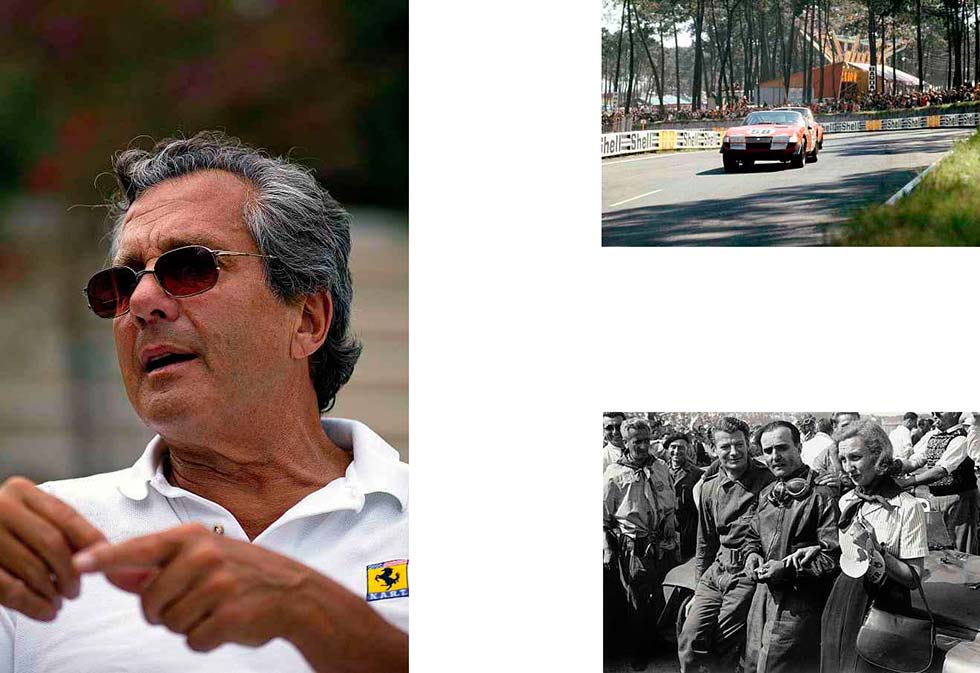
No, the Daytona is actually a very good long-distance racer because it has a great engine, it’s strong and reliable – but it’s very heavy. Even the engine is heavy. Ours had an aluminium body to try to get the weight down to around 2300lb, a hotter engine with different pistons, cams, carbs, the usual stuff. Think we got it up to around 450bhp.
The thing with the big Daytona is it can’t do what it can’t do. In endurance racing there’s no point in overdriving the car and, with all that heft, you can’t go in too hard and you have to be careful of the brakes. As my dad used to say, ‘You gotta be there at the end – no-one remembers the first lap.’
Ferrari builds some wonderful cars but they should have stretched the Daytona’s engine. As the stock car boys say: ‘If you want more horsepower, dig a bigger hole.’ Ferrari didn’t really develop the Daytona, which is a shame because it had great potential and could have become really awesome – I mean, look at what Porsche did with the 911. The RS is a delight to drive.
Having done thousands of miles in Daytonas I must admit one of the best drives I ever experienced was on the road from Modena to Paris. The only instrument I used was the tach; the speedo was irrelevant. That’s where a Daytona comes alive. I think it is a better car than the later 365 BB – I mean, who wants an engine over the gearbox? And the 288 GTO is no better because it’d fry its brakes after one run down the mountain. No, Ferrari’s next great car was the F40. People say the Daytona is tricky but I think it’s enormous fun. Just bear in mind, it can’t do what it can’t do, so don’t go in too hard over your head.
Left, below and bottom Chinetti Jr (left) and (below) at Le Mans, 1971; Chinetti Sr, centre, pictured with Lord Selsdon after winning Le Mans with the Ferrari 166M in 1949.
FOR WHAT IT’S WORTH
Simon Kidston takes us on the Daytona’s rollercoaster market ride
Daytona. Whether you’re talking the track, the wristwatch or the car, it’s a name that conjures speed, style and sexiness. Paul Newman’s own Rolex Daytona was a gift from his wife back in ’68, and was just auctioned for $17.5 million, which trumps any other Daytona as an investment.
Had Mrs Newman walked into a Ferrari showroom instead of the Rolex one four decades ago and laid down the required $20,000 for Maranello’s then-latest supercar, the rate of return wouldn’t have been quite as stellar, and servicing, storage and insurance wouldn’t compare as favourably either. Yet, leaving aside the monumental premium for Newman’s ownership, a one-owner Ferrari Daytona might fetch a million dollars, or say £700,000 today. That’s 50 times the original purchase price in almost 50 years.
It wasn’t always this way. Some 1400 new Daytonas found buyers on both sides of the Atlantic despite its relatively conservative design, outselling its great rival, Lamborghini’s radical mid-engined Miura, by almost two to one. Come 1973, however, and the brutal OPEC oil crisis, supercars became almost unsaleable overnight. The last few Daytona Spyders sat unsold at the docks in LA and had to be discounted by the factory to preferred clients, while in Britain two-year-old Daytona coupés were partexchanged for Ford Granadas.
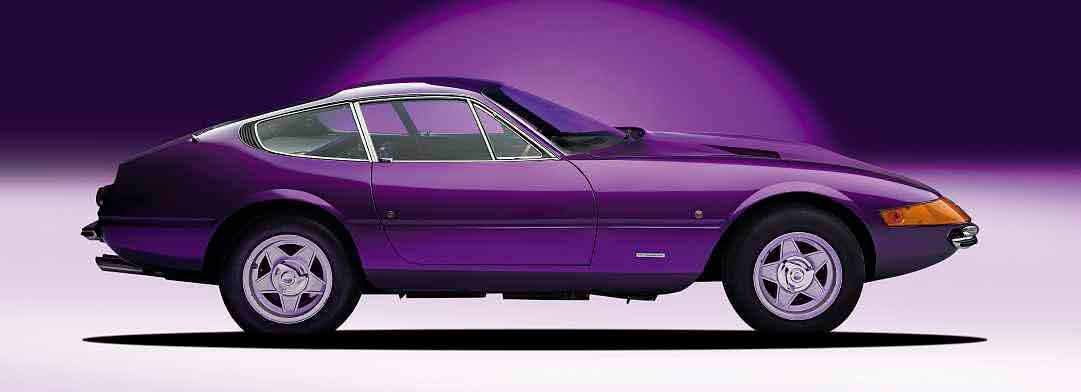
Come the 1980s, the idea of collecting cars entered the mainstream. The Daytona’s successor, the Boxer, never endeared itself to enthusiasts quite like the iconic Daytona, with its endless bonnet, short tail and oldfashioned macho grunt. By the time the Boxer was in turn replaced by the Testarossa in 1984, a superb, used Daytona coupé already commanded the same price as the other two, something previously unheard of.
Fast-forward to the late-1980s classic car boom, and the first car I was sent to value as a 21-year-old novice in the auction business was a red Daytona coupé in north London. The patient vendor kindly offered me a ride and to this day I remember the scent of Italian leather, the promise of excitement when he started it up, and the unrelenting mechanical savagery as we roared past commuters in a blur of exotic colour.
A month later we sold it to an Italian collector for £190,000. Six months on and it was worth 50% more. Another six months and that had become another 50%. Yet only a year later it was worth just £80,000. Markets are seldom one-way.
The last ten years have been gentler and, although the most recent five have seen prices reach all-time peaks and fall back a little since 2014, Daytonas have still doubled in value. Spyders, of which 121 were made, remain the most-sought after if you leave aside the 15 coupés built by the factory for Group 4 competition.
My insider’s tip for ones to buy? Either the very earliest coupés with Plexiglas enclosed headlights, preferably in a rare and stylish colour (think blue, green, gold, brown – yes, really – or black), or one of the Europeanspec Spyders. Because 96 went to the USA, that means only 25 cars, of which seven were right-hand drive. Rarity and originality are key; condition is less important, especially for valuable Spyders.
And yes, they’re still great to drive. Just don’t mention the brakes.
THE UPS AND DOWNS OF DAYTONA VALUES
